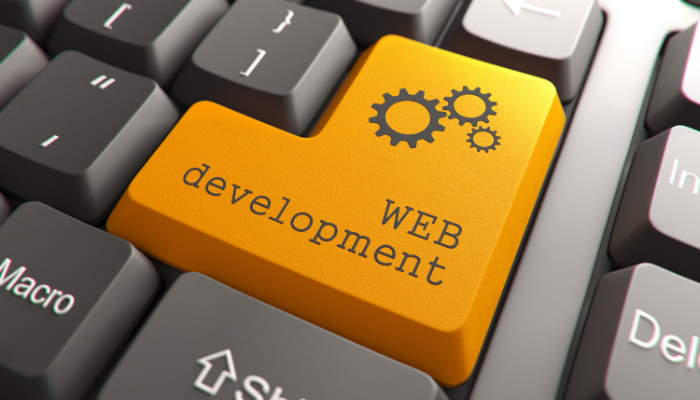With the number of mobile devices now outnumbering people worldwide, it’s no wonder that the mobile app market is anticipated to reach 189B installs and generate $186B in revenue by 2027,
With such exciting prospects, it’s easy to see why so many businesses are jumping on the mobile application development bandwagon. Whether you’re thinking about boosting customer engagement, streamlining your operations, or launching something entirely new, a mobile app could be just what your business needs.
But where do you begin? If you’re considering developing a mobile app, knowing the process is key. In this guide, we’ll walk you through each step of creating the app you’ve been dreaming about, sharing insights from our experience along the way. Ready to get started?
Let’s jump in.
Key Stages of the Mobile App Development Process
Step 1: Ideation and Market Research
Before you move into the development phase, it’s crucial to lay a strong foundation. This begins with thoughtful ideation and comprehensive market research—the cornerstones of your app’s success.
Defining the Purpose of Your App
Your app’s purpose is its guiding star. Ask yourself, what problem does your app solve? Whether it’s simplifying transactions, enhancing customer service, or providing a unique user experience, your app needs a clear purpose. This will not only help in development but also in marketing your app to the right audience.
Identifying Your Target Audience
Knowing your audience is critical. Are you targeting millennials with a penchant for tech, or is your app aimed at busy professionals needing quick solutions? Understanding who will use your app influences everything from design to functionality. Create user personas to map out your ideal users’ demographics, preferences, and pain points.
Conducting Competitive Analysis
In a market flooded with apps, standing out is crucial. Conducting a competitive analysis helps you understand what similar apps are doing right and where they fall short. This insight can guide you in developing features that not only meet industry standards but exceed them.
Understanding Market Trends and User Needs
Market trends shift rapidly, and user needs evolve with them. Stay informed about the latest trends in mobile application development, such as user interface innovations, preferred functionalities, and emerging technologies. Align your app’s features with these trends to ensure it meets current user expectations.
Step 2: Planning and Strategy
With a solid understanding of your app’s purpose and market context, the next step is planning and strategy. This stage is where ideas transform into actionable steps.
Setting Clear Objectives and Goals
Clearly defined objectives keep your project on track. Whether your goal is to increase brand loyalty, streamline operations, or generate revenue, it should be measurable and time-bound. This clarity helps in aligning your team and resources effectively.
Creating a Project Roadmap
A project roadmap is your blueprint for success. It outlines each phase of development, from design to deployment, with specific milestones and deadlines. This roadmap should be realistic, factoring in potential challenges and delays.
Budgeting and Resource Allocation
Budgeting is more than just numbers—it’s about prioritizing what matters most. Allocate resources based on the features that will drive the most value for your app. Consider costs for design, development, testing, and marketing, ensuring you have enough budget to cover post-launch activities like updates and maintenance.
Choosing the Right Development Approach
Choosing between Native, Hybrid, or Web development depends on your app’s goals, budget, and audience.
- Native apps offer the best performance and user experience but are more costly and time-consuming.
- Hybrid apps provide a balance between performance and cost, using a single codebase for multiple platforms.
- Web apps are the most affordable but might lack the seamless user experience of native apps.
Step 3: Designing the User Experience (UX)
User experience (UX) design is the heart of your app. A well-designed UX can make the difference between an app that users love and one they quickly abandon.
Importance of UX in Mobile Apps
UX is not just about how your app looks—it’s about how it feels. A smooth, intuitive experience keeps users engaged and coming back. Good UX design increases user satisfaction, reduces churn, and can significantly impact your app’s ratings and reviews.
Wireframing and Prototyping
Wireframing is the skeleton of your app, outlining its structure and flow. Prototyping takes it a step further, creating an interactive model of your app. These tools help in visualizing the user journey and identifying potential issues early in the design process.
User Journey Mapping
Mapping the user journey involves outlining the steps a user takes to achieve a goal within your app. This process helps in identifying key interactions and ensuring that each step is as smooth and intuitive as possible.
UI/UX Design Best Practices
Adopting best practices in UI/UX design ensures your app is both functional and visually appealing. Focus on consistency, accessibility, and simplicity. Ensure that navigation is intuitive and that the design reflects your brand’s identity.
To make sure you benefit from top-notch UI/UI design, collaborate with Codewave. We craft digital interfaces and experiences that are human-centric, 3X more engaging, and all at 30% lesser cost. With our UI/UX design services, businesses have achieved:
- 45% increase in user engagement
- 2X faster task completion time
- 25% reduction in user errors
- 30% boost in conversion rates
Experience the Codewave difference and watch your app’s performance soar.
Step 4: Technical Architecture and Technology Stack
The technical architecture and technology stack form the backbone of your app. They determine how your app functions, scales, and interacts with other services.
Understanding the Technical Requirements
Before diving into development, it’s crucial to outline the technical requirements. This includes defining the backend architecture, database management, and third-party integrations. A clear understanding of these requirements helps in selecting the appropriate technology stack.
Choosing the Right Technology Stack
Your technology stack includes the programming languages, frameworks, and tools you’ll use to build your app. Here’s a basic breakdown:
- Front-end: This is what users interact with directly. Technologies like React Native, Flutter, or Swift are popular choices.
- Back-end: This is the server-side of your app, managing data and business logic. Common choices include Node.js, Ruby on Rails, and Python.
- Database: For data storage, consider SQL (e.g., MySQL, PostgreSQL) or NoSQL (e.g., MongoDB) depending on your app’s needs.
Choosing the Right Development Platform
Selecting the right development platform is a crucial decision that affects your app’s performance, user experience, and development timeline. Each option—Hybrid Apps, Native Apps, and Cross-platform Applications—has its pros and cons, and the best choice depends on your specific business needs, budget, and target audience.
Hybrid Apps:
- Pros: Hybrid apps are built using web technologies like HTML, CSS, and JavaScript but are wrapped in a native container. This allows them to run on multiple platforms with a single codebase, reducing development time and costs.
- Cons: However, hybrid apps might not deliver the same performance or user experience as native apps, especially for complex functionalities.
Example: An example of a hybrid app would be an e-commerce app that needs to be available on both iOS and Android without the need for platform-specific features.
Native Apps:
- Pros: Native apps are developed specifically for one platform (iOS or Android) using platform-specific languages like Swift for iOS or Kotlin for Android. This allows them to fully leverage the device’s capabilities, offering the best performance and user experience.
- Cons: The downside is the higher cost and longer development time since you’ll need separate codebases for each platform.
Example: A mobile banking app that requires tight integration with device hardware (like fingerprint or facial recognition) would benefit from being developed as a native app.
Cross-platform Applications:
- Pros: Cross-platform apps are built using frameworks like React Native or Flutter, which allow a single codebase to be used across multiple platforms. This approach offers a balance between cost-efficiency and performance, providing near-native performance while reducing development time.
- Cons: Although better than hybrid in terms of performance, cross-platform apps might still encounter limitations when accessing platform-specific features.
Example: An app for a social media platform that needs to launch quickly on both iOS and Android could be a good candidate for a cross-platform approach.
Integrating APIs and Third-party Services
APIs and third-party services can enhance your app’s functionality without having to build everything from scratch. Whether it’s integrating payment gateways, social media logins, or analytics tools, careful selection of these services is crucial for performance and security.
Ensuring Security and Scalability
Security should never be an afterthought. Implementing strong authentication, data encryption, and secure APIs protects user data. Scalability is equally important—your app should handle growth seamlessly without compromising performance.
Step 5: Development Process
The development process is where your app starts to come to life. It’s about writing code, building features, and ensuring everything works together smoothly.
Agile vs. Waterfall Methodologies
Choosing the right development methodology can influence your app’s success. Agile offers flexibility with iterative development and continuous feedback, making it ideal for complex projects. Waterfall, on the other hand, is a linear approach, best suited for projects with clearly defined requirements.
Setting Up the Development Environment
A well-configured development environment is crucial for productivity. Ensure that your development team has the right tools, access to resources, and a standardized environment to avoid conflicts and streamline the development process.
Front-End Development
Front-end development focuses on building the user interface and user experience. This involves converting the design into code, ensuring that the app is responsive, and implementing interactive elements.
Back-End Development
Back-end development is the backbone of your app. It handles server-side logic, database interactions, and API integrations. The focus here is on creating a robust, secure, and scalable infrastructure that supports the app’s functionalities.
Testing and Quality Assurance
Testing is integrated into the development phase to catch issues early. This involves writing unit tests, performing integration tests, and ensuring that each component works as intended before moving on to the next.
We know the development process can seem overwhelming, with so many intricacies and decisions to make. But with Codewave, you don’t have to worry. Our custom mobile app development service is designed to guide you through each step, ensuring clarity and confidence throughout.
We focus on building ‘lean’ custom mobile app software that includes the 20% of features that will deliver 80% of the impact. Trust Codewave to bring your vision to life, without the confusion.
Step 6: Testing and Quality Assurance
Testing is an ongoing process that ensures your app meets the highest quality standards. It’s not just about finding bugs; it’s about ensuring a seamless user experience.
Importance of Thorough Testing
Thorough testing reduces the risk of post-launch issues, which can damage your app’s reputation. It’s essential to test all aspects of the app, from functionality to performance and security.
Types of Testing
There are several types of testing you need to conduct:
- Unit Testing: Tests individual components of the app.
- Integration Testing: Ensures different parts of the app work together.
- System Testing: Tests the entire app as a whole.
- User Acceptance Testing (UAT): Involves real users testing the app to ensure it meets their needs.
Automated Testing Tools and Techniques
Automated testing can speed up the testing process and improve accuracy. Tools like Selenium, Appium, and JUnit can automate repetitive testing tasks, allowing your team to focus on more complex testing scenarios.
Beta Testing and Feedback Gathering
Beta testing is an opportunity to gather feedback from real users before the official launch. This feedback is invaluable for identifying any remaining issues and making final adjustments.
Step 7: Deployment and Launch
Deploying your app is a critical step that requires careful planning and execution. It’s the moment when your app goes live and becomes available to users.
Preparing for App Store Submission
Submitting your app to the App Store (iOS) or Google Play (Android) involves several steps, including ensuring your app meets all guidelines, creating compelling app store listings, and preparing promotional materials.
Optimizing for App Store SEO (ASO)
App Store Optimization (ASO) is crucial for visibility in app stores. This involves optimizing your app’s title, description, keywords, and visuals to improve its ranking and attract more downloads.
Pre-launch Marketing Strategies
Pre-launch marketing builds anticipation and creates buzz around your app. Utilize social media, content marketing, and influencer partnerships to generate interest and drive initial downloads.
Launching the App: Best Practices
Launching your app is just the beginning. Ensure a smooth launch by monitoring the app’s performance, responding to user feedback, and making any necessary adjustments quickly.
Step 8: Post-Launch Activities
The work doesn’t stop once your app is launched. Post-launch activities are essential for maintaining your app’s success and ensuring its long-term growth.
Monitoring Performance and Analytics
Use analytics tools to monitor your app’s performance, track user behavior, and identify areas for improvement. Regularly review metrics like user retention, engagement, and conversion rates.
User Feedback and Continuous Improvement
User feedback is crucial for continuous improvement. Actively seek out and respond to feedback, and use it to make informed decisions about updates and new features.
Updates, Maintenance, and Support
Regular updates keep your app relevant and secure. Maintenance involves fixing bugs, optimizing performance, and ensuring compatibility with new OS versions. Providing ongoing support builds trust and enhances user satisfaction.
Scaling and Adding New Features
As your app grows, you may need to scale its infrastructure to handle increased traffic. Consider adding new features based on user feedback and market trends to keep your app competitive.
Step 9: Marketing and Promotion
Marketing and promotion are key to your app’s success. Even the best app will struggle if no one knows about it.
Developing a Post-Launch Marketing Strategy
A well-planned marketing strategy is essential for driving downloads and user engagement. Focus on a mix of paid advertising, content marketing, and social media to reach your target audience effectively.
Leveraging Social Media, Content Marketing, and Influencers
Social media is a powerful tool for promoting your app. Create engaging content, run targeted ads, and partner with influencers to reach a wider audience. Content marketing, including blogs, videos, and podcasts, can also help establish your app’s presence.
App Monetization Strategies
If your app is designed to generate revenue, consider monetization strategies like in-app purchases, ads, and subscriptions. Analyze your user base to determine the best approach and optimize your app for profitability.
Analyzing Marketing ROI
Regularly analyze your marketing efforts to ensure they’re delivering a strong return on investment (ROI). Use tools like Google Analytics and social media insights to track the effectiveness of your campaigns.
Step 10: Future Trends in Mobile Application Development
As the mobile app industry continues to grow, staying informed about the latest trends is essential to keeping your app competitive. By understanding and adapting to these developments, you can ensure that your app remains relevant and continues to meet the needs of your users.
Emerging Technologies
Technologies like AI, AR/VR, and IoT are revolutionizing mobile app development. Consider how these innovations can enhance your app and provide a unique user experience.
Example: Imagine a fitness app that doesn’t just track your runs but also acts as your personal coach, adjusting your workout plan based on real-time data. This is possible with AI integration. AI, or Artificial Intelligence, can analyze user data, predict behavior, and provide personalized experiences. For instance, AI-powered chatbots can offer customer support within the app, resolving issues without human intervention.
AR (Augmented Reality) and VR (Virtual Reality) are also game-changers. Take Ikea’s AR app as an example—it allows users to visualize how furniture will look in their home before making a purchase. This kind of immersive experience isn’t just cool; it significantly improves customer engagement and decision-making.
IoT (Internet of Things) is another trend worth noting. For example, smart home apps that control lighting, security systems, or thermostats are becoming increasingly popular. Integrating IoT in your mobile app can provide users with convenient control over their connected devices, making your app an essential part of their daily lives.
The Role of 5G in Mobile App Development
5G technology is set to transform mobile app development with faster speeds and lower latency. Prepare your app to leverage these advancements for better performance and new features.
Example: With 5G, your app’s performance can be elevated to a new level. Think of a mobile game that requires low latency and high-speed data transfer. With 5G, the game can deliver a smoother and more responsive experience, crucial for real-time multiplayer games.
5G can also enhance video streaming apps by allowing higher resolution and faster buffering. For instance, a telemedicine app could benefit from 5G by providing seamless, high-definition video consultations, making remote healthcare more accessible and effective.
Moreover, 5G opens up possibilities for apps that rely on augmented reality or virtual reality, as these technologies require high bandwidth and low latency. Imagine an AR shopping app where users can instantly try on clothes virtually, with real-time feedback and seamless interaction, all made possible by 5G’s capabilities.
Sustainable and Ethical App Development Practices
As consumers become more conscious of ethical and environmental issues, consider incorporating sustainable practices into your app development process. This could involve reducing your app’s energy consumption or ensuring data privacy and security.
Example: Sustainability in app development isn’t just a buzzword; it’s becoming a priority for both developers and users. For example, a company might develop an app that monitors and reduces energy consumption in smart homes, directly contributing to a greener environment.
Ethical app development also involves ensuring data privacy and security. Consider the app Signal, which prioritizes end-to-end encryption, ensuring that user communications are secure and private. As data breaches become more common, apps that focus on protecting user data will build greater trust with their users.
Additionally, ethical practices might include designing apps that are accessible to people with disabilities. For instance, incorporating features like voice commands, screen readers, or haptic feedback can make your app more inclusive, expanding your user base and demonstrating a commitment to accessibility.
Preparing for the Future: Continuous Learning and Adaptation
The mobile app industry is constantly evolving. Stay ahead by continuously learning, adapting to new technologies, and listening to your users.
Example: The mobile app industry never stands still, and neither should you. Take the case of app developers who embraced Swift, Apple’s programming language, shortly after its release. By learning and adapting to this new language, they were able to create faster, more reliable iOS apps that took full advantage of the latest iOS updates.
Similarly, staying informed about trends like machine learning or blockchain can give you an edge in creating innovative apps. For instance, integrating machine learning in an e-commerce app can personalize the shopping experience by suggesting products based on user behavior. Meanwhile, blockchain can be used in financial apps to ensure secure and transparent transactions.
Adapting to these changes doesn’t just mean learning new technologies; it also involves listening to your users. Apps like Instagram continuously evolve based on user feedback, adding new features like Stories or Reels to keep users engaged and attract new ones.
How Long Does Mobile Application Development Take?
The timeline for developing a mobile app can vary widely depending on several factors, including the complexity of the app, the features you want to include, the platforms you’re targeting (iOS, Android, or both), and the size of the development team.
For instance, a simple app with basic features might take about 2-3 months to develop, including the time for planning, design, development, testing, and deployment. On the other hand, a more complex app with custom designs, multiple integrations, and advanced functionalities could take anywhere from 6 to 12 months or even longer.
Factors Influencing the Development Timeline
Scope and Complexity
- Simple Apps: These include basic functionalities like a login system, user profiles, and simple content displays. For example, a basic fitness tracker app that logs workouts and displays data might fall into this category. Such apps typically take around 2-3 months to develop.
- Moderately Complex Apps: Apps with more features, such as payment gateways, API integrations, or real-time chat functions, require more development time. For instance, an e-commerce app with user accounts, product catalogs, and a payment system might take 4-6 months.
- Highly Complex Apps: These apps include advanced features like AI-powered recommendations, AR/VR capabilities, or extensive third-party integrations. An example could be a mobile banking app with secure transactions, real-time notifications, and integration with various financial services. Development time can range from 6 months to over a year.
Design and User Experience (UX):
- Custom Design Requirements: Apps with unique, custom designs take longer to develop. For example, creating a unique user interface (UI) that reflects your brand identity or a complex user journey requires additional design and development time.
- Prototyping and Testing: Iterative design processes, where prototypes are tested and refined multiple times, extend the timeline. Ensuring that the UX is intuitive and user-friendly is crucial but time-consuming.
Platform and Device Support:
- Single Platform (iOS or Android): Developing for one platform usually takes less time than building for both. If you’re targeting just iOS or Android, you can expect a quicker turnaround.
- Cross-Platform Development: If you want your app available on both iOS and Android, and possibly on tablets or other devices, it will take longer. Cross-platform frameworks like React Native or Flutter can speed up the process, but they still require careful consideration and testing for each platform.
Third-Party Integrations:
- APIs and External Services: Integrating third-party services, such as payment gateways (like Stripe), social media logins, or analytics tools, adds to the development time. Each integration requires development, testing, and sometimes custom adjustments to ensure compatibility and security.
- Custom Backend Development: If your app needs a custom backend to manage data, user authentication, or real-time updates, this will add significant time to the development process. Backend development often runs parallel with front-end work but still requires coordination and testing.
Development Methodology:
- Agile Development: Agile allows for flexibility and ongoing iteration, which can both speed up or extend timelines depending on project needs. Regular sprints and continuous feedback loops help identify issues early but may prolong the process as changes are implemented.
- Waterfall Development: This linear approach often results in a longer initial timeline as each phase (planning, design, development, testing, deployment) is completed before the next begins. However, it might reduce time spent on revisions.
Testing and Quality Assurance:
- Comprehensive Testing: Thorough testing, including unit, integration, system, and user acceptance testing, ensures a high-quality app but extends the timeline. For example, testing across different devices, operating systems, and network conditions can be time-consuming but is necessary for a polished final product.
- Beta Testing: Running a beta test with real users can reveal issues that weren’t identified during internal testing. While invaluable for quality assurance, gathering feedback and making necessary adjustments adds additional weeks to the development timeline.
Post-Launch Considerations:
- Ongoing Updates and Maintenance: Even after launch, updates, bug fixes, and new feature rollouts will continue to require development time. Planning for post-launch activities should be part of the overall timeline.
Understanding these factors can help set realistic expectations for how long it will take to develop your mobile app. Proper planning, clear communication, and a well-organized development process are key to delivering your app on time and within budget.
Must read if you’re aiming to kickstart your journey as a developer—Steps to Becoming a Mobile App Developer. Get the essential insights to build your first app!
Choosing the Right Mobile Application Development Company
Selecting the right mobile app development company is a critical decision that can significantly impact the success of your project. Whether you’re a startup or an established enterprise, partnering with the right developers ensures that your app meets your business goals, resonates with your target audience, and stands out in a competitive market.
By carefully following these steps, you’ll ensure your project is entrusted to capable hands.
1. Define Your Project Requirements
Before you start looking for a development partner, it’s essential to have a clear understanding of your project requirements. Ask yourself the following questions:
- What is the primary goal of your app?
- Who is your target audience?
- What are the key features and functionalities you need?
- What is your budget and timeline?
Having well-defined requirements will not only help you communicate effectively with potential development companies but also allow you to evaluate whether they are a good fit for your project.
2. Assess Experience and Expertise
When evaluating potential development companies, prioritize those with a proven track record in mobile app development. Look for companies that:
- Have Relevant Experience: Check if they have experience in developing apps similar to yours, both in terms of functionality and industry. For example, if you need an e-commerce app, a company with a portfolio of successful e-commerce projects would be ideal.
- Possess Technical Expertise: Ensure the company has expertise in the specific technologies and platforms you plan to use, such as iOS, Android, cross-platform frameworks, or specific APIs and integrations.
3. Review Portfolio and Case Studies
A company’s portfolio is a window into their capabilities. Reviewing their past projects can give you insights into:
- Design Quality: Look for apps that are visually appealing and offer a seamless user experience. This indicates that the company values both aesthetics and usability.
- Functionality: Assess whether the apps they’ve developed are feature-rich and perform well across different devices and platforms.
- Client Testimonials and Case Studies: Look for detailed case studies that highlight the challenges faced during development and how they were overcome. Client testimonials can also provide valuable insights into the company’s reliability and customer satisfaction.
To see what a top-tier mobile app development portfolio looks like, check out Codewave’s impressive collection of projects. Our work showcases our commitment to design excellence, functionality, and delivering results that our clients love.
4. Evaluate Communication and Collaboration
Effective communication is crucial for the success of any development project. During your initial interactions with potential companies, assess their:
- Responsiveness: Are they prompt in replying to your queries? A company that values timely communication will likely keep you updated throughout the development process.
- Understanding of Your Vision: Do they take the time to understand your business goals and app vision? A good development partner will not only listen but also provide valuable feedback and suggestions.
- Project Management Approach: Inquire about their project management processes. Do they use Agile, Waterfall, or a hybrid approach? Understand how they plan to keep you involved, manage timelines, and handle any challenges that arise.
5. Consider Pricing and Budget Compatibility
Budget is a significant factor in choosing a development partner. However, it’s essential to strike a balance between cost and quality:
- Transparent Pricing: Look for companies that offer clear and detailed pricing structures. Beware of vague estimates that could lead to unexpected costs later in the project.
- Value for Money: Don’t simply opt for the cheapest option. Consider the value you’ll receive in terms of quality, expertise, and ongoing support. Sometimes, paying a bit more upfront can save you money in the long run by reducing the need for costly revisions or updates.
- Flexibility in Payment Plans: Some companies offer flexible payment options, such as fixed-price contracts, hourly rates, or milestone-based payments. Choose a structure that aligns with your budget and risk tolerance.
6. Check Technical Support and Maintenance Services
Post-launch support is as important as the development process itself. Ensure that the company offers:
- Ongoing Maintenance: Apps require regular updates to fix bugs, improve performance, and stay compatible with new OS versions. Confirm that the company provides ongoing maintenance services and understand the costs involved.
- Technical Support: Reliable technical support is crucial for addressing any issues that arise after launch. Ask about their support availability, response times, and escalation processes.
- Future Scalability: Your app might need new features or expansions in the future. Choose a company that is open to long-term collaboration and has the capability to scale your app as your business grows.
7. Evaluate Security Measures
Security is a top priority in mobile app development. The company you choose should adhere to best practices in security to protect your app and user data:
- Data Protection: Ensure the company implements strong encryption, secure data storage, and other necessary measures to safeguard user data.
- Compliance: If your app will handle sensitive information (such as financial data or personal health records), the company should be familiar with industry regulations like GDPR, HIPAA, or PCI-DSS and ensure your app is compliant.
- Vulnerability Testing: Ask about their approach to identifying and mitigating security vulnerabilities during the development process.
8. Assess Cultural Fit
Finally, consider the cultural fit between your organization and the development company. A strong cultural alignment can make collaboration smoother and more productive:
- Work Ethic: Do their values and work ethics align with yours? A shared commitment to quality, transparency, and customer satisfaction can enhance the partnership.
- Time Zone and Language: If you’re working with an offshore company, consider the time zone differences and language barriers. Ensure they have a clear communication strategy in place to handle these challenges effectively.
9. Request a Pilot Project
If you’re still uncertain, consider starting with a smaller, pilot project before committing to a full-scale development. This allows you to:
- Test Their Capabilities: A pilot project gives you a firsthand experience of the company’s development process, communication style, and technical expertise.
- Minimize Risk: It reduces the risk of investing heavily in a company that might not meet your expectations. Based on the pilot project’s success, you can decide whether to proceed with the larger project.
Thinking beyond mobile? Learn about the Custom Web Application Development Process, Costs, and Timelines.
Codewave: The Go-To Choice for Mobile App Development
Codewave is a leading mobile app development company, with over 400 projects successfully completed, earning the trust of clients worldwide not just for the quality of our work, but for delivering solutions that drive business growth.
We follow a design-led thinking approach, which involves deeply understanding user needs, empathizing with their challenges, and crafting intuitive, innovative solutions that align with business objectives. This ensures that every app we develop is not only functional but also delivers an exceptional user experience, making Codewave the preferred choice for businesses aiming for impactful digital transformation.
Mobile App Development services we provide:
- iOS Mobile App Development
Got an idea that needs to shine on Apple devices? Our team of iOS experts is here to turn your vision into a sleek, high-performing app that works flawlessly across iPhones and iPads. We focus on delivering a top-notch user experience that feels right at home in the Apple ecosystem.
- Android Mobile App Development
The Android market is huge, and we’re here to help you tap into it. Our Android developers are pros at creating apps that stand out in the crowded Google Play Store. Whether you’re targeting the latest Android devices or need broad compatibility, we’ll build an app that performs beautifully and reaches your audience.
- Cross-Platform Mobile App Development
Why choose between iOS and Android when you can have both? With our cross-platform development services, we create apps that work seamlessly across multiple platforms, saving you time and money. You’ll get the best of both worlds—an app that looks and feels great on any device.
- MVP Development
Have a great idea but want to test the waters before going all-in? We specialize in building Minimum Viable Products (MVPs) that let you validate your concept quickly. We’ll help you develop a lean, functional version of your app that you can launch, gather feedback on, and iterate to perfection.
- Digital Product Consulting
Sometimes you need a little extra guidance to bring your digital product to life. That’s where our consulting services come in. We work with you to refine your product strategy, choose the right technologies, and ensure your app aligns with your business goals. Whether you’re starting from scratch or looking to improve an existing product, we’ve got the expertise to help you succeed.
Have an App Idea? Let’s Make It Happen Together!
Conclusion
If you’re planning to develop a mobile app, there’s no better time than now to get started. The mobile app market is booming, and the potential to grow your business through a well-designed app is immense. With the guidance provided in this blog, you’re equipped with the knowledge needed to navigate the mobile app development journey successfully.
Remember, “The success of an app lies in the hands of those who build it.” Choosing the right development partner is crucial, and at Codewave, we understand that better than anyone. Our Design Thinking approach to mobile app development ensures that every decision is user-centered, resulting in an app that not only meets your business goals but also creates an outstanding user experience that your audience will love.
Codewave is a UX first design thinking & digital transformation services company, designing & engineering innovative mobile apps, cloud, & edge solutions.







